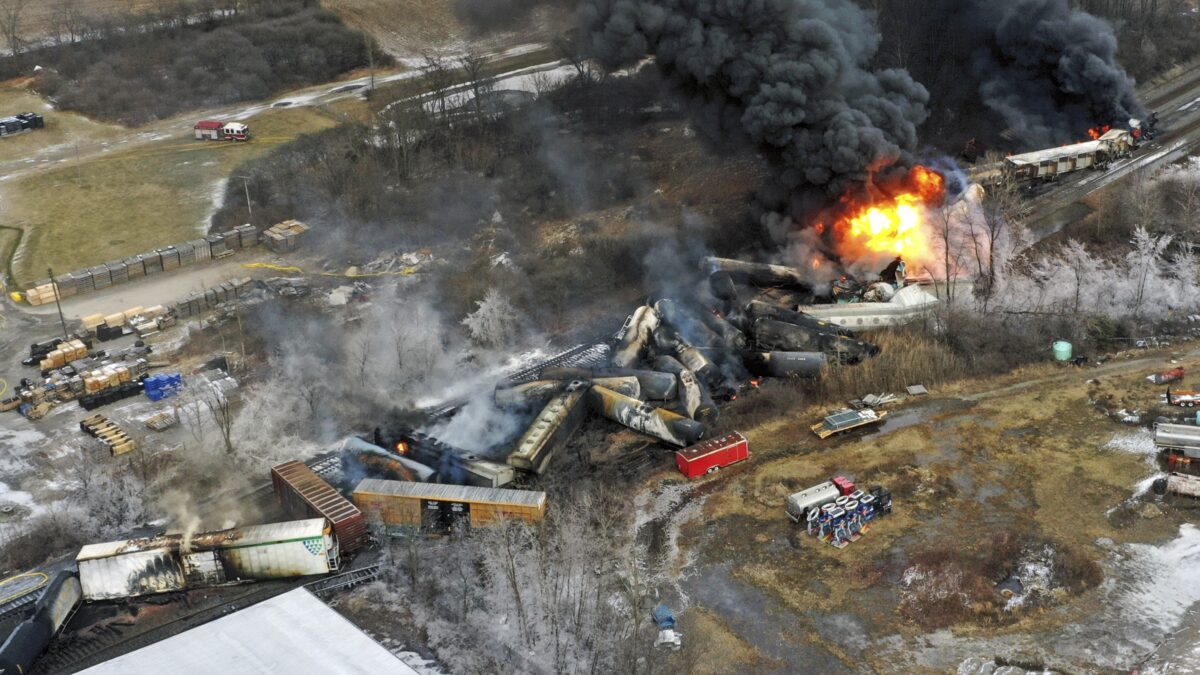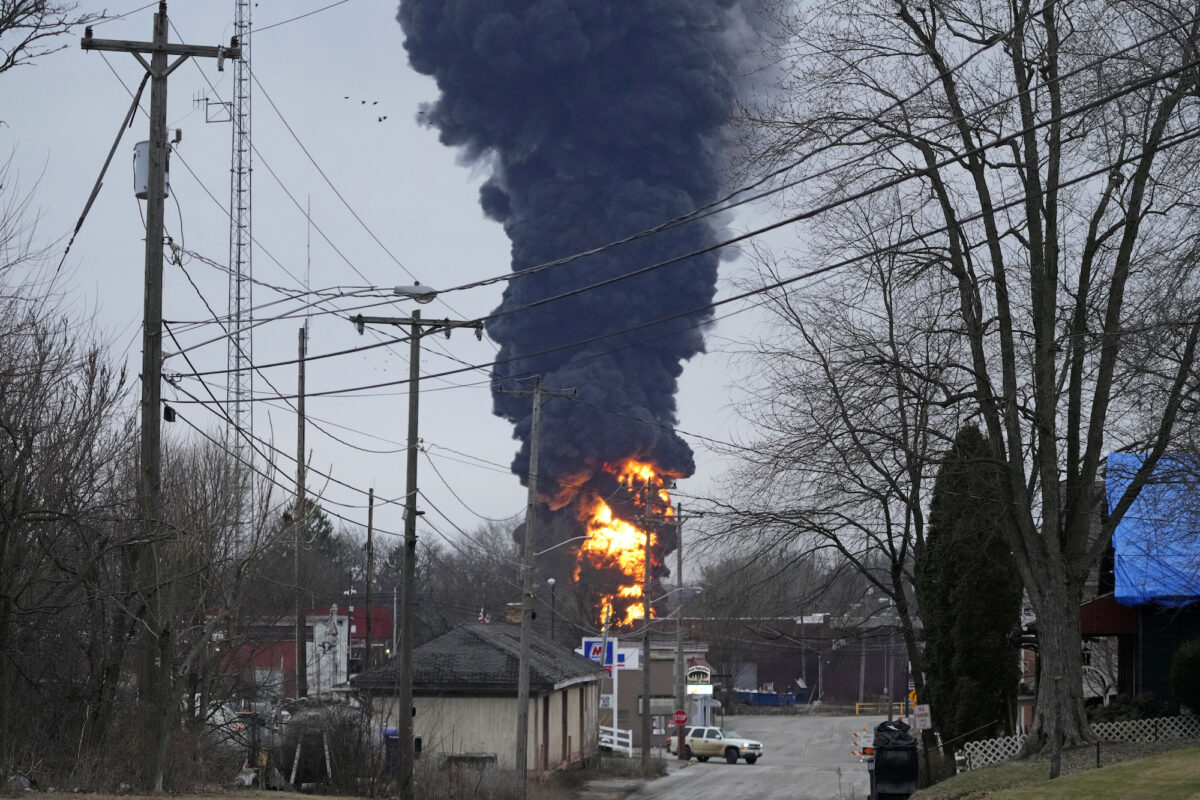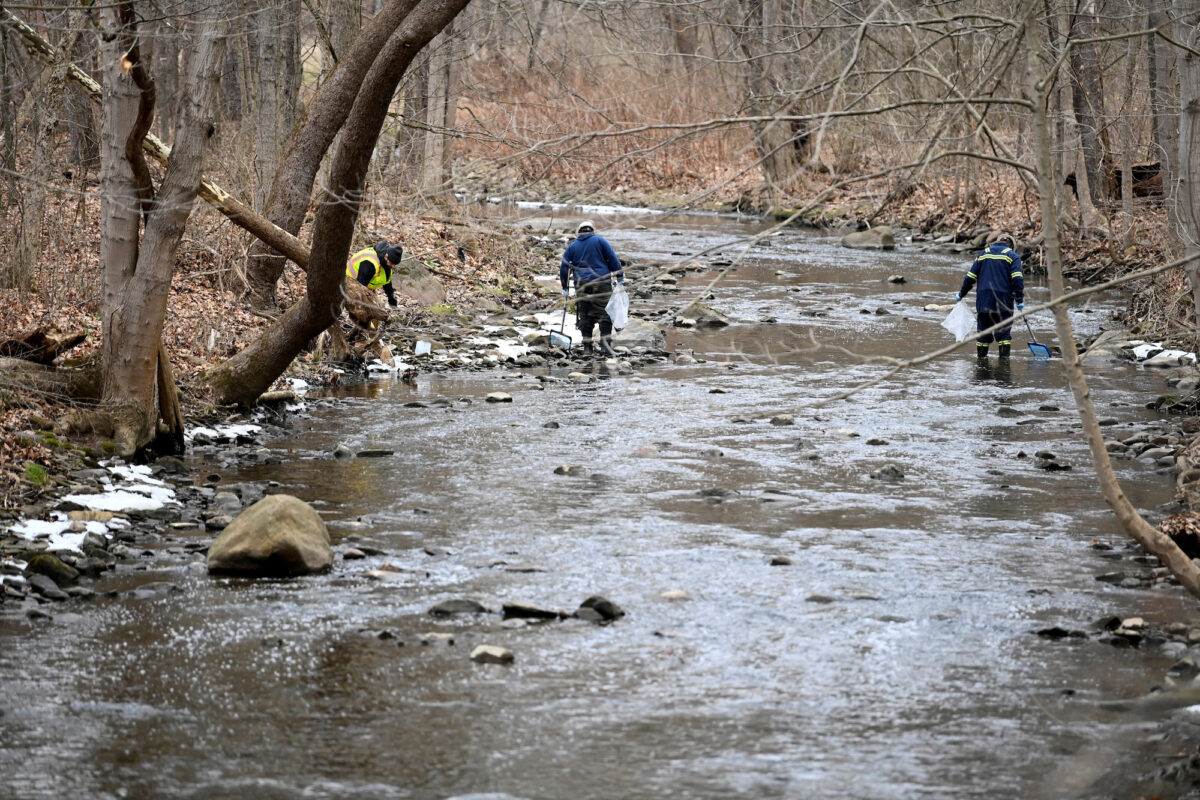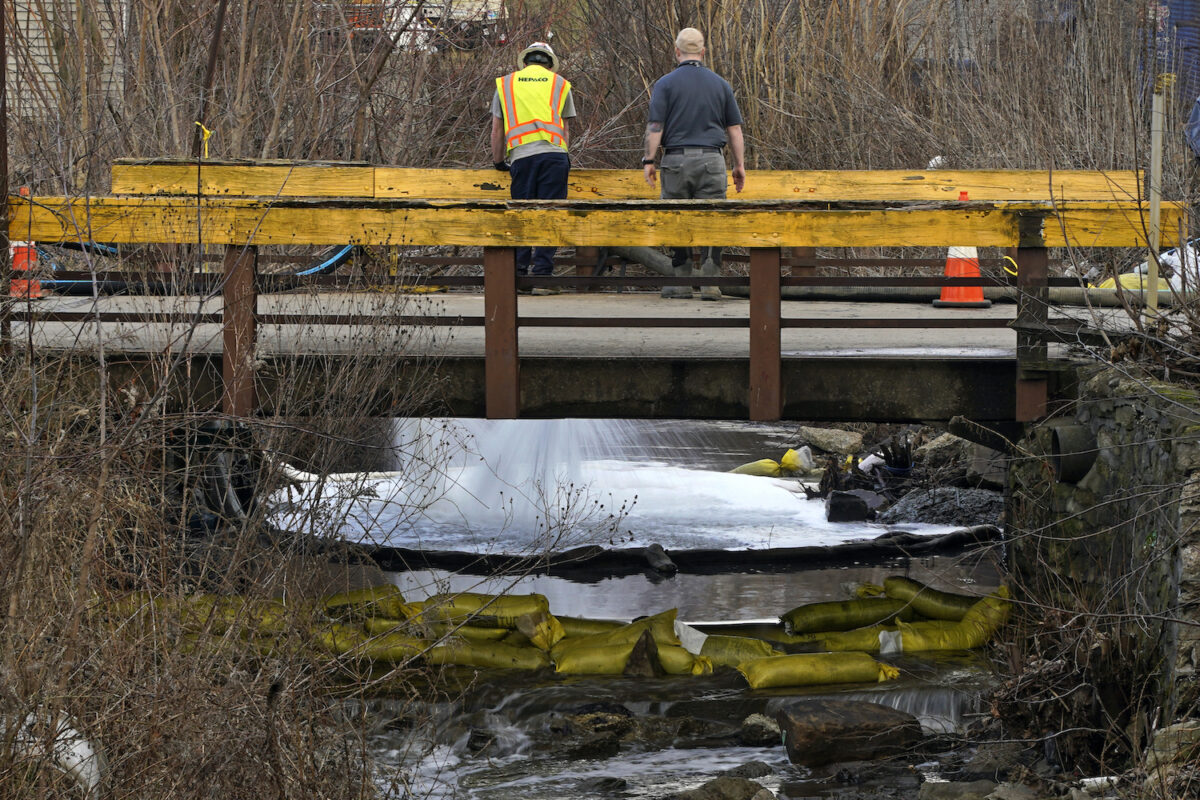Security camera footage has emerged showing that the Ohio train that derailed in East Palestine may have been on fire for 20 miles before it finally went off the tracks and burst into flames.
The footage, which was first obtained by the Pittsburgh Post-Gazette, was taken by a security camera at an equipment plant in Salem, Ohio. East Palestine is around 20 miles away from Salem.
As the train passes the plant, what looks like flames and sparks can be seen in the video underneath the train cars.
The National Transportation Safety Board (NTSB), which is investigating the derailment, appeared to reference the video—and others—at a news conference in the days immediately after the incident took place on Feb. 3.
“We’re also looking at a lot of different footage that has been provided to the investigators out there to determine if there’s some data on footage that we have from videos and cameras that might tell us something more that what might have happened to cause this accident,” Michael Graham, a member of the NTSB, said in a Feb. 4 briefing.

‘Mechanical Issues’
At a follow-on briefing on Feb. 5, Graham said that investigators had also secured the locomotive data recorder earlier that day, along with forward- and inward-facing camera footage and audio recordings. Graham said the locomotive footage would be sent to a Washington lab for evaluation and analysis, before adding that other videos have emerged suggesting a possible problem with one of the rail car’s axles.
“We have obtained two videos which show preliminary indications of mechanical issues on one of the rail car axles,” Graham said at the Feb. 5 briefing, adding that the NTSB team was working to identify which rail car experienced the potential mechanical issue.
Graham said the train crew received an alarm from a “wayside defect detector shortly before the derailment, indicating a mechanical issue.”
“Then an emergency brake application initiated,” he continued, adding that a preliminary investigative report was expected within several weeks, though a full probe could take as long as 24 months.

Some of the footage was again referenced in a Feb. 14 update, in which the NTSB said that a surveillance video from a residence showed “what appears to be a wheel bearing in the final stage of overheat failure moments before the derailment.”
“The wheelset from the suspected railcar has been collected as evidence for metallurgical examination,” the NTSB stated.
Investigators have found the suspected overheated wheel bearing, and engineers from the NTSB Materials Laboratory in Washington would examine it.
Investigators will complete their examination of the 11 tank cars that contained hazardous materials once they’re fully decontaminated, the NTSB said.

A total of around 50 train cars derailed in East Palestine on Feb. 3, with some containing the toxic chemical vinyl chloride, which at high concentrations can be deadly.
Short-term exposure to the chemical can cause dizziness, headaches, and respiratory problems. Long-term exposure has been linked to various health problems, including liver damage, immune system dysfunction, and certain types of cancer.
The derailment prompted evacuation orders in East Palestine, a town of around 5,000.
The wreckage burned for days, and officials worried that the highly-flammable vinyl chloride could lead to an uncontrolled explosion, so crews engineered controlled detonations.

Besides being burned off in a controlled fashion, contaminants from derailed cars also spilled into waterways, with officials tracking a large “plume” of chemicals flowing down the Ohio River.
Around 3,500 fish have been killed by the chemical spill, according to an estimate by the Ohio Department of Natural Resources, with around 7 miles of streams affected by the toxins.
Tiffani Kavalec, the head of the Ohio Environmental Protection Agency’s (EPA) water management subdivision, said in a news conference on Tuesday that the plume is on its way toward Huntington, West Virginia, and that it consists mostly of “fire combustion chemicals.”
Kavalec said that the plume is moving downriver at around 1 mph and becoming increasingly more diluted, adding that the Ohio EPA doesn’t believe the chemicals pose a threat to drinking water. The Ohio River is “able to dilute the pollutants pretty quickly,” Kavalec said, adding that “we are seeing very low levels of contaminants” in the river.

The EPA said that water sampling is being carried out at various points along the river to ensure drinking water is safe.
“State and local agencies are conducting sampling throughout the Ohio River to ensure drinking water intakes aren’t affected, and EPA is continuing to assist the state with sampling efforts at water treatment intake points along the Ohio River,” the EPA said in a Feb. 14 update.
Bottled Water Advisory
Ohio officials have urged some locals living near the train derailment site in East Palestine to only use bottled water amid concerns over the potential health impacts of hazardous chemicals that spilled into the Ohio River.
Ohio Gov. Mike DeWine told a press conference on Tuesday that the pollution did not pose a serious threat to the 5 million or so people who rely on the Ohio River for their drinking water. Still, DeWine and other Ohio officials warned that residents using private wells near the derailment should only use bottled water.
“For right now, I think bottled water’s the right answer,” Ohio Health Director Bruce Vanderhoff said at the press conference. Asked by reporters whether he would return home amid cleanup efforts, DeWine said he’d be back home but would not be drinking water from the tap.
“I think that I would be drinking the bottled water,” DeWine said. “And I would be continuing to find out what the tests were showing as far as the air.”
“I would be alert and concerned,” he continued, adding, “But I think I would probably be back in my house.”
DeWine said on Feb. 8 that it was safe for local residents to return to their homes.

Lingering Questions
People in and around East Palestine have been asking whether the air and water are safe for their families, pets, and livestock after the derailment caused a fire that sent a cloud of toxic smoke over the town.
There have been reports of sick or dead animals and persistent odors, while the EPA said that a number of hazardous chemicals were found at the site of the derailment, including vinyl chloride, ethylene glycol monobutyl ether, ethylhexyl acrylate, isobutylene, and butyl acrylate.
The EPA has been carrying out community air monitoring in East Palestine around the clock, saying in Tuesday’s update that it has “not detected any levels of health concern in the community that are attributed to the train derailment.”
As of Tuesday, the agency had screened 396 homes, and “no detections of vinyl chloride or hydrogen chloride were identified,” the EPA said.
But while the EPA has said that air monitoring hasn’t detected any hazards to health associated with the derailment, some locals have told media outlets that their health has suffered since returning home.
Jack Phillips contributed to this report. Article cross-posted from our premium news partners at The Epoch Times.
Five Things New “Preppers” Forget When Getting Ready for Bad Times Ahead
The preparedness community is growing faster than it has in decades. Even during peak times such as Y2K, the economic downturn of 2008, and Covid, the vast majority of Americans made sure they had plenty of toilet paper but didn’t really stockpile anything else.
Things have changed. There’s a growing anxiety in this presidential election year that has prompted more Americans to get prepared for crazy events in the future. Some of it is being driven by fearmongers, but there are valid concerns with the economy, food supply, pharmaceuticals, the energy grid, and mass rioting that have pushed average Americans into “prepper” mode.
There are degrees of preparedness. One does not have to be a full-blown “doomsday prepper” living off-grid in a secure Montana bunker in order to be ahead of the curve. In many ways, preparedness isn’t about being able to perfectly handle every conceivable situation. It’s about being less dependent on government for as long as possible. Those who have proper “preps” will not be waiting for FEMA to distribute emergency supplies to the desperate masses.
Below are five things people new to preparedness (and sometimes even those with experience) often forget as they get ready. All five are common sense notions that do not rely on doomsday in order to be useful. It may be nice to own a tank during the apocalypse but there’s not much you can do with it until things get really crazy. The recommendations below can have places in the lives of average Americans whether doomsday comes or not.
Note: The information provided by this publication or any related communications is for informational purposes only and should not be considered as financial advice. We do not provide personalized investment, financial, or legal advice.
Secured Wealth
Whether in the bank or held in a retirement account, most Americans feel that their life’s savings is relatively secure. At least they did until the last couple of years when de-banking, geopolitical turmoil, and the threat of Central Bank Digital Currencies reared their ugly heads.
It behooves Americans to diversify their holdings. If there’s a triggering event or series of events that cripple the financial systems or devalue the U.S. Dollar, wealth can evaporate quickly. To hedge against potential turmoil, many Americans are looking in two directions: Crypto and physical precious metals.
There are huge advantages to cryptocurrencies, but there are also inherent risks because “virtual” money can become challenging to spend. Add in the push by central banks and governments to regulate or even replace cryptocurrencies with their own versions they control and the risks amplify. There’s nothing wrong with cryptocurrencies today but things can change rapidly.
As for physical precious metals, many Americans pay cash to keep plenty on hand in their safe. Rolling over or transferring retirement accounts into self-directed IRAs is also a popular option, but there are caveats. It can often take weeks or even months to get the gold and silver shipped if the owner chooses to close their account. This is why Genesis Gold Group stands out. Their relationship with the depositories allows for rapid closure and shipping, often in less than 10 days from the time the account holder makes their move. This can come in handy if things appear to be heading south.
Lots of Potable Water
One of the biggest shocks that hit new preppers is understanding how much potable water they need in order to survive. Experts claim one gallon of water per person per day is necessary. Even the most conservative estimates put it at over half-a-gallon. That means that for a family of four, they’ll need around 120 gallons of water to survive for a month if the taps turn off and the stores empty out.
Being near a fresh water source, whether it’s a river, lake, or well, is a best practice among experienced preppers. It’s necessary to have a water filter as well, even if the taps are still working. Many refuse to drink tap water even when there is no emergency. Berkey was our previous favorite but they’re under attack from regulators so the Alexapure systems are solid replacements.
For those in the city or away from fresh water sources, storage is the best option. This can be challenging because proper water storage containers take up a lot of room and are difficult to move if the need arises. For “bug in” situations, having a larger container that stores hundreds or even thousands of gallons is better than stacking 1-5 gallon containers. Unfortunately, they won’t be easily transportable and they can cost a lot to install.
Water is critical. If chaos erupts and water infrastructure is compromised, having a large backup supply can be lifesaving.
Pharmaceuticals and Medical Supplies
There are multiple threats specific to the medical supply chain. With Chinese and Indian imports accounting for over 90% of pharmaceutical ingredients in the United States, deteriorating relations could make it impossible to get the medicines and antibiotics many of us need.
Stocking up many prescription medications can be hard. Doctors generally do not like to prescribe large batches of drugs even if they are shelf-stable for extended periods of time. It is a best practice to ask your doctor if they can prescribe a larger amount. Today, some are sympathetic to concerns about pharmacies running out or becoming inaccessible. Tell them your concerns. It’s worth a shot. The worst they can do is say no.
If your doctor is unwilling to help you stock up on medicines, then Jase Medical is a good alternative. Through telehealth, they can prescribe daily meds or antibiotics that are shipped to your door. As proponents of medical freedom, they empathize with those who want to have enough medical supplies on hand in case things go wrong.
Energy Sources
The vast majority of Americans are locked into the grid. This has proven to be a massive liability when the grid goes down. Unfortunately, there are no inexpensive remedies.
Those living off-grid had to either spend a lot of money or effort (or both) to get their alternative energy sources like solar set up. For those who do not want to go so far, it’s still a best practice to have backup power sources. Diesel generators and portable solar panels are the two most popular, and while they’re not inexpensive they are not out of reach of most Americans who are concerned about being without power for extended periods of time.
Natural gas is another necessity for many, but that’s far more challenging to replace. Having alternatives for heating and cooking that can be powered if gas and electric grids go down is important. Have a backup for items that require power such as manual can openers. If you’re stuck eating canned foods for a while and all you have is an electric opener, you’ll have problems.
Don’t Forget the Protein
When most think about “prepping,” they think about their food supply. More Americans are turning to gardening and homesteading as ways to produce their own food. Others are working with local farmers and ranchers to purchase directly from the sources. This is a good idea whether doomsday comes or not, but it’s particularly important if the food supply chain is broken.
Most grocery stores have about one to two weeks worth of food, as do most American households. Grocers rely heavily on truckers to receive their ongoing shipments. In a crisis, the current process can fail. It behooves Americans for multiple reasons to localize their food purchases as much as possible.
Long-term storage is another popular option. Canned foods, MREs, and freeze dried meals are selling out quickly even as prices rise. But one component that is conspicuously absent in shelf-stable food is high-quality protein. Most survival food companies offer low quality “protein buckets” or cans of meat, but they are often barely edible.
Prepper All-Naturals offers premium cuts of steak that have been cooked sous vide and freeze dried to give them a 25-year shelf life. They offer Ribeye, NY Strip, and Tenderloin among others.
Having buckets of beans and rice is a good start, but keeping a solid supply of high-quality protein isn’t just healthier. It can help a family maintain normalcy through crises.
Prepare Without Fear
With all the challenges we face as Americans today, it can be emotionally draining. Citizens are scared and there’s nothing irrational about their concerns. Being prepared and making lifestyle changes to secure necessities can go a long way toward overcoming the fears that plague us. We should hope and pray for the best but prepare for the worst. And if the worst does come, then knowing we did what we could to be ready for it will help us face those challenges with confidence.
Coffee the Christian way: Promised Grounds



ANYONE who believes what the Government Weenies are saying is an idiot of the highest order.
Resign Buttigieg! NOW
Hang Buttigieg! NOW
There, fixed it for you.
Is anyone asking about the possibility of sabotage?
I think it only fair that the usual reporters from the usual agencies set up operations in one of the local hotels. Buttigieg and his family can put up at a BnB to experience local life and support East Palestinian residents. DeWine saying “he would move back”; maybe he can spend a couple of weeks there also.
that is not a ‘hot wheel’ as the news is trying to make out. the entire car is in flames on the inside and the flames are leaking out thru the side door and the floor.
The Biden puppet forced the rail unions to stop striking by threatening them all with life in prison. The rail unions were striking in November/December over something called PSR.
PSR is “Precision Scheduled Railroading”…in short, it means fewer workers, less maintenance (!), fewer days off, longer trains, and unsafe practices…all in the name of keeping the trains running at all times to maximize profits.
The profits of note were then taken by DJOOISH owned hedge funds that own the railroad companies so they can buy back their own stock (which they’ve been doing at record rates ever since PSR became common practice in the last 5-10 years, company dependent).
On Feb. 3 a train heading from Illinois to Conway station ran over a sensor that detects heat in the wheels and axles. It’s called a “hot box detector”. It gave them an alarm and TOLD THEM that they had an axle on fire. Instead of STOPPING and REPAIRING IT, they were ordered BY DISPATCHERS to continue moving towards Conway station. So they KNEW that it was on fire for 20+ miles. It wasn’t on fire and they just…DIDN’T KNOW.
They ABSOLUTELY KNEW that it was on fire.
They were ABSOLUTELY TOLD TO KEEP MOVING AT SPEED.
This wasn’t an ACCIDENT, it was INTENTIONAL.
FOR SHEKELS, folks. For shekels.
A long train of abuses